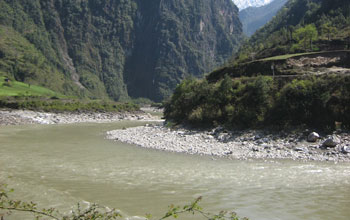
The ecologically diverse and scenic Nu River flows near the Yunnan-Tibet border.
Credit: Kelly Kibler
Download the high-resolution JPG version of the image. (2.2 MB)
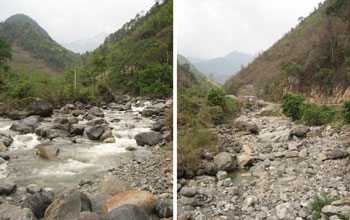
A tributary of the Nu River is dry below a dam, its waters diverted by a hydropower project.
Credit: Kelly Kibler
Download the high-resolution JPG version of the image. (8.3 MB)
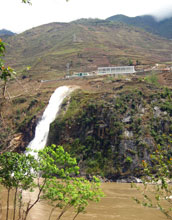
Small hydropower plant discharges water from tributary to main channel of the Nu River.
Credit: Kelly Kibler
Download the high-resolution JPG version of the image. (3.6 MB)
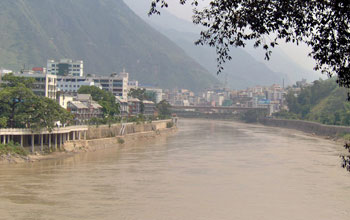
Town of Liuku on the Salween (Nu) River in Yunnan.
Credit: Wikimedia Commons
Download the high-resolution JPG version of the image. (771 KB)
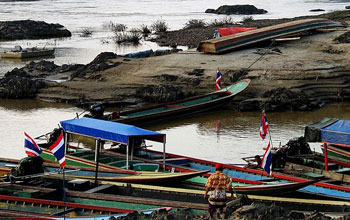
Salween, or Nu, River forming the boundary between Burma and Thailand.
Credit: Wikimedia Commons
Download the high-resolution JPG version of the image. (100 KB)
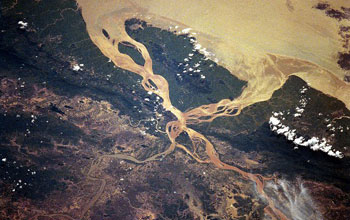
The Salween Delta from space (south is to the upper left).
Credit: Wikimedia Commons
Download the high-resolution JPG version of the image. (203 KB)
A fresh look at the environmental impacts of dams on an ecologically
diverse and partially protected river in China found that small dams can
pose a greater threat to ecosystems and natural landscapes than large
dams.
Large dams have been considered more harmful than their smaller counterparts.
But
researchers' surveys of habitat loss and damage at several dam sites on
the Nu River and its tributaries in Yunnan Province revealed that the
environmental effects of small dams are often greater--sometimes by
several orders of magnitude--than of large dams.
"Small dams
have hidden detrimental effects, particularly when effects accumulate"
through multiple dam sites, said Kelly Kibler, a water resources
engineer who led the study while at Oregon State University.
"That's
one of the main outcomes, to demonstrate that the perceived absence of
negative effects from small hydropower is not always correct."
She
and Desiree Tullos, also a water resources engineer at Oregon State,
report their findings in a paper accepted for publication in Water Resources Research, a journal of the American Geophysical Union (AGU).
"These
researchers have taken advantage of what is essentially a natural
experiment that allowed them to compare the effects of hydroelectric
dams of different sizes," said Tom Baerwald of the National Science
Foundation's (NSF) Directorate for Social, Behavioral & Economic
Sciences, which co-funded the research with other NSF directorates.
"The results are applicable beyond this region."
To compare the
effects of small and large dams, Kibler investigated 31 small dams built
on tributaries to China's Nu River and four large dams proposed for the
main stem of the Nu River.
She assessed the environmental
effects of these dams in 14 categories--including the area and quality
of habitat lost, the length of river channel affected, the amount of
conservation land affected, and the landslide risk.
Because
information regarding large dams is restricted under the Chinese State
Secrets Act, Kibler modeled the potential effects of the four large dams
using publicly-available information from hydropower companies,
development agencies, and academic literature.
After evaluating
data from the field, hydrologic models, and Environmental Impact
Assessment reports on the small dams, Kibler and Tullos concluded that
effects of the small dams exceeded those of large dams on nine out of
the 14 characteristics they studied.
One particularly
detrimental effect of the small dams is that they often divert the flow
of the river to hydropower stations, leaving several kilometers of river
bed dewatered, Kibler said.
From its headwaters in the Tibetan Plateau, the Nu River flows through China, Myanmar (Burma) and Thailand.
"While
the number of small hydropower dams in operation or planned for
tributaries to the Nu River is unreported," the authors state in their
paper, "our field surveys indicate that nearly one hundred small dams
currently exist within Nujiang Prefecture alone."
Thirteen large hydropower dams are proposed for the mainstem of the Nu River in Tibet and Yunnan Province in China.
Environmental, social, and economic factors make the Nu River basin extremely sensitive to hydropower installations.
In
addition to supporting several protected species, the region is home to
a large proportion of ethnic minorities and valuable natural resources,
the authors report.
While large hydropower projects are managed
by the central government, and both large and small hydropower projects
undergo environmental impact assessments, decisions about small
hydropower projects are made at a provincial or other regional level and
often receive less oversight, Kibler and Tullos state.
The lack
of regulation paired with a dearth of communication between small dam
projects in China allows for the effects to multiply and accumulate
through several dam sites, the authors write.
To mitigate the
detrimental effects of small dams, there's a need for comprehensive
planning for low-impact energy development, said Kibler and Tullos.
"The
lack of analyses of the cumulative effects of small hydropower," Kibler
said, "is a significant research gap with important policy
implications."
-NSF-
Media Contacts
Cheryl Dybas, NSF (703) 292-7734 cdybas@nsf.gov
Peter Weiss, AGU (202) 777-7507 pweiss@agu.org
Peter Weiss, AGU (202) 777-7507 pweiss@agu.org
The National Science Foundation (NSF) is an independent federal
agency that supports fundamental research and education across all
fields of science and engineering. In fiscal year (FY) 2012, its budget
was $7.0 billion. NSF funds reach all 50 states through grants to nearly
2,000 colleges, universities and other institutions. Each year, NSF
receives about 50,000 competitive requests for funding, and makes about
11,500 new funding awards. NSF also awards about $593 million in
professional and service contracts yearly.
Useful NSF Web Sites:
NSF Home Page: http://www.nsf.gov
NSF News: http://www.nsf.gov/news/
For the News Media: http://www.nsf.gov/news/newsroom.jsp
Science and Engineering Statistics: http://www.nsf.gov/statistics/
Awards Searches: http://www.nsf.gov/awardsearch/
NSF Home Page: http://www.nsf.gov
NSF News: http://www.nsf.gov/news/
For the News Media: http://www.nsf.gov/news/newsroom.jsp
Science and Engineering Statistics: http://www.nsf.gov/statistics/
Awards Searches: http://www.nsf.gov/awardsearch/
The National Science Foundation (NSF).
Guillermo Gonzalo Sánchez Achutegui
ayabaca@gmail.com
ayabaca@hotmail.com
ayabaca@yahoo.com
Inscríbete en el Foro del blog y participa : A Vuelo De Un Quinde - El Foro!

No hay comentarios:
Publicar un comentario